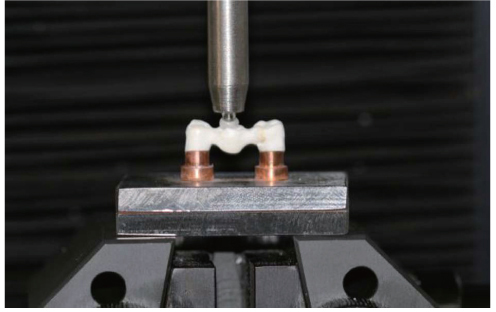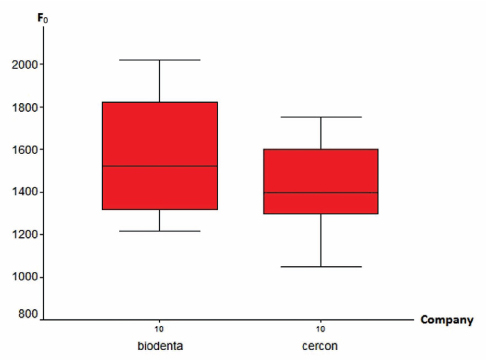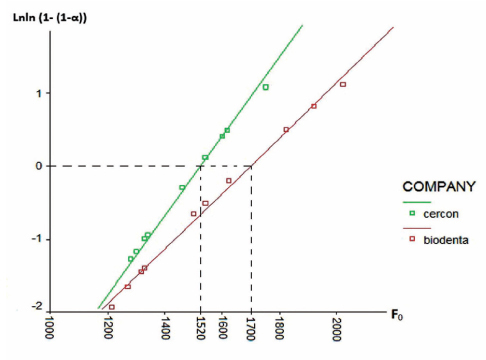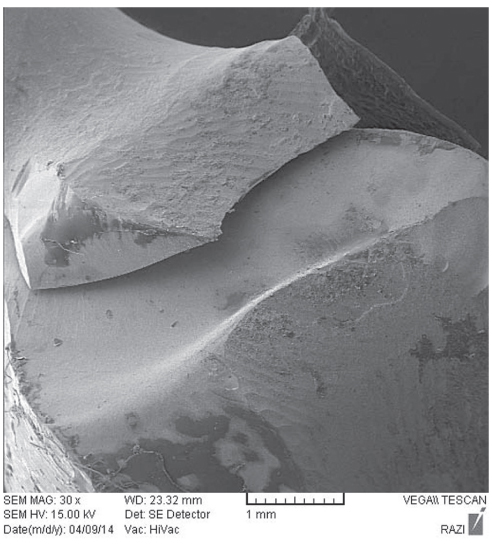J Adv Prosthodont.
2014 Oct;6(5):346-350. 10.4047/jap.2014.6.5.346.
Flexural strengths of implant-supported zirconia based bridges in posterior regions
- Affiliations
-
- 1Dental Implants Research Center, Department of Prosthodontics, School of Dentistry, Isfahan University of Medical Sciences, Isfahan, Iran.
- 2Torabinezhad Dental Research Center, Department of Prosthodontics, School of Dentistry, Isfahan University of Medical Sciences, Isfahan, Iran. soufiashafiei@gmail.com
- 3Dental Students Research Center, School of Dentistry, Isfahan University of Medical Sciences, Isfahan, Iran.
- KMID: 2284734
- DOI: http://doi.org/10.4047/jap.2014.6.5.346
Abstract
- PURPOSE
Impact forces in implant supported FDP (fixed dental prosthesis) are higher than that of tooth supported FDPs and the compositions used in frameworks also has a paramount role for biomechanical reasons. The aim of this study was to evaluate the flexural strength of two different zirconia frameworks.
MATERIALS AND METHODS
Two implant abutments with 3.8 mm and 4.5 mm platform were used as premolar and molar. They were mounted vertically in an acrylic resin block. A model with steel retainers and removable abutments was fabricated by milling machine; and 10 FDP frameworks were fabricated for each Biodenta and Cercon systems. All samples were thermo-cycled for 2000 times in 5-55degrees C temperature and embedded in 37degrees C artificial saliva for one week. The flexural test was done by a rod with 2 mm ending diameter which was applied to the multi-electromechanical machine. The force was inserted until observing fracture. The collected data were analyzed with SPSS software ver.15, using Weibull modulus and independent t-test with the level of significance at alpha=.05.
RESULTS
The mean load bearing capacity values were higher in Biodenta but with no significant differences (P>.05). The Biodenta frameworks showed higher load bearing capacity (F0=1700) than Cercon frameworks (F0=1520) but the reliability (m) was higher in Cercon (m=7.5).
CONCLUSION
There was no significant difference between flexural strengths of both zirconia based framework systems; and both Biodenta and Cercon systems are capable to withstand biting force (even parafunctions) in posterior implant-supported bridges with no significant differences.
Figure
Reference
-
1. Scurria MS, Bader JD, Shugars DA. Meta-analysis of fixed partial denture survival: prostheses and abutments. J Prosthet Dent. 1998; 79:459–464.2. Tan K, Pjetursson BE, Lang NP, Chan ES. A systematic review of the survival and complication rates of fixed partial dentures (FPDs) after an observation period of at least 5 years. Clin Oral Implants Res. 2004; 15:654–666.3. Raigrodski AJ. Contemporary materials and technologies for all-ceramic fixed partial dentures: a review of the literature. J Prosthet Dent. 2004; 92:557–562.4. Christel P, Meunier A, Heller M, Torre JP, Peille CN. Mechanical properties and short-term in-vivo evaluation of yttrium-oxide-partially-stabilized zirconia. J Biomed Mater Res. 1989; 23:45–61.5. Tinschert J, Natt G, Hassenpflug S, Spiekermann H. Status of current CAD/CAM technology in dental medicine. Int J Comput Dent. 2004; 7:25–45.6. Filser F, Kocher P, Weibel F, Lüthy H, Schärer P, Gauckler LJ. Reliability and strength of all-ceramic dental restorations fabricated by direct ceramic machining (DCM). Int J Comput Dent. 2001; 4:89–106.7. Coornaert J, Adriaens P, De Boever J. Long-term clinical study of porcelain-fused-to-gold restorations. J Prosthet Dent. 1984; 51:338–342.8. Valderhaug J. A 15-year clinical evaluation of fixed prosthodontics. Acta Odontol Scand. 1991; 49:35–40.9. Raigrodski AJ, Chiche GJ, Potiket N, Hochstedler JL, Mohamed SE, Billiot S, Mercante DE. The efficacy of posterior three-unit zirconium-oxide-based ceramic fixed partial dental prostheses: a prospective clinical pilot study. J Prosthet Dent. 2006; 96:237–244.10. Holm C, Tidehag P, Tillberg A, Molin M. Longevity and quality of FPDs: a retrospective study of restorations 30, 20, and 10 years after insertion. Int J Prosthodont. 2003; 16:283–289.11. Leempoel PJ, Käyser AF, Van Rossum GM, De Haan AF. The survival rate of bridges. A study of 1674 bridges in 40 Dutch general practices. J Oral Rehabil. 1995; 22:327–330.12. Kelly JR. Dental ceramics: what is this stuff anyway? J Am Dent Assoc. 2008; 139:4S–7S.13. Kawai K, Urano M. Adherence of plaque components to different restorative materials. Oper Dent. 2001; 26:396–400.14. Harder S, Wolfart S, Eschbach S, Kern M. Eight-year outcome of posterior inlay-retained all-ceramic fixed dental prostheses. J Dent. 2010; 38:875–881.15. Studart AR, Filser F, Kocher P, Gauckler LJ. In vitro lifetime of dental ceramics under cyclic loading in water. Biomaterials. 2007; 28:2695–2705.16. Jacobs R, van Steenberghe D. Comparison between implant-supported prostheses and teeth regarding passive threshold level. Int J Oral Maxillofac Implants. 1993; 8:549–554.17. Bacchi A, Consani RL, Mesquita MF, dos Santos MB. Stress distribution in fixed-partial prosthesis and peri-implant bone tissue with different framework materials and vertical misfit levels: a three-dimensional finite element analysis. J Oral Sci. 2013; 55:239–244.18. Sailer I, Fehér A, Filser F, Lüthy H, Gauckler LJ, Schärer P, Franz Hämmerle CH. Prospective clinical study of zirconia posterior fixed partial dentures: 3-year follow-up. Quintessence Int. 2006; 37:685–693.19. Okabayashi S, Nomoto S, Sato T, Miho O. Influence of proximal supportive design of zirconia framework on fracture load of veneering porcelain. Dent Mater J. 2013; 32:572–577.20. Bacchi A, Consani RL, Mesquita MF, Dos Santos MB. Effect of framework material and vertical misfit on stress distribution in implant-supported partial prosthesis under load application: 3-D finite element analysis. Acta Odontol Scand. 2013; 71:1243–1249.21. Beuer F, Steff B, Naumann M, Sorensen JA. Load-bearing capacity of all-ceramic three-unit fixed partial dentures with different computer-aided design (CAD)/computer-aided manufacturing (CAM) fabricated framework materials. Eur J Oral Sci. 2008; 116:381–386.22. Kohorst P, Herzog TJ, Borchers L, Stiesch-Scholz M. Load-bearing capacity of all-ceramic posterior four-unit fixed partial dentures with different zirconia frameworks. Eur J Oral Sci. 2007; 115:161–166.23. Lüthy H, Filser F, Loeffel O, Schumacher M, Gauckler LJ, Hammerle CH. Strength and reliability of four-unit all-ceramic posterior bridges. Dent Mater. 2005; 21:930–937.24. Salimi H, Mosharraf R, Savabi O. Effect of framework design on fracture resistance of zirconium oxide posterior fixed partial dentures. Dent Res J (Isfahan). 2012; 9:764–769.25. Sailer I, Fehér A, Filser F, Gauckler LJ, Lüthy H, Hämmerle CH. Five-year clinical results of zirconia frameworks for posterior fixed partial dentures. Int J Prosthodont. 2007; 20:383–388.26. Tinschert J, Schulze KA, Natt G, Latzke P, Heussen N, Spiekermann H. Clinical behavior of zirconia-based fixed partial dentures made of DC-Zirkon: 3-year results. Int J Prosthodont. 2008; 21:217–222.27. Tsumita M, Kokubo Y, Vult von Steyern P, Fukushima S. Effect of framework shape on the fracture strength of implant-supported all-ceramic fixed partial dentures in the molar region. J Prosthodont. 2008; 17:274–285.28. Oh WS, Anusavice KJ. Effect of connector design on the fracture resistance of all-ceramic fixed partial dentures. J Prosthet Dent. 2002; 87:536–542.29. Oh W, Götzen N, Anusavice KJ. Influence of connector design on fracture probability of ceramic fixed-partial dentures. J Dent Res. 2002; 81:623–627.30. Scherrer SS, de Rijk WG. The fracture resistance of all-ceramic crowns on supporting structures with different elastic moduli. Int J Prosthodont. 1993; 6:462–467.31. Kelly JR. Perspectives on strength. Dent Mater. 1995; 11:103–110.32. Lundgren D, Laurell L. Occlusal forces in prosthetically restored dentitions: a methodological study. J Oral Rehabil. 1984; 11:29–37.33. Tinschert J, Zwez D, Marx R, Anusavice KJ. Structural reliability of alumina-, feldspar-, leucite-, mica- and zirconiabased ceramics. J Dent. 2000; 28:529–535.34. Kelly JR, Tesk JA, Sorensen JA. Failure of all-ceramic fixed partial dentures in vitro and in vivo: analysis and modeling. J Dent Res. 1995; 74:1253–1258.35. Molin MK, Onesti MP, Petersson TB, Dérand TB. Three-dimensional finite element analyses of all-ceramic posterior fixed partial dentures with different designs. Int J Prosthodont. 2007; 20:89–91.36. Augereau D, Pierrisnard L, Barquins M. Relevance of the finite element method to optimize fixed partial denture design. Part I. Influence of the size of the connector on the magnitude of strain. Clin Oral Investig. 1998; 2:36–39.
- Full Text Links
- Actions
-
Cited
- CITED
-
- Close
- Share
- Similar articles
-
- The study of flexural strength of various zirconia ceramics
- Effect of different coloring liquids on the flexural strength of multilayered zirconia
- Comparative study of peri-implantitis between implant supported bridges and splinted crowns: a retrospective study
- Considerations for the Survival of Complete Arch Implant-Supported Zirconia Restorations; Status of Antagonistic Arches and Stress Distribution on Frameworks: A Case Report
- Clinical Evaluation of Lithium Disilicate Pressed Zirconia and Monolithic Zirconia in Posterior Implant-Supported Prostheses





